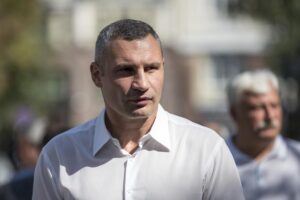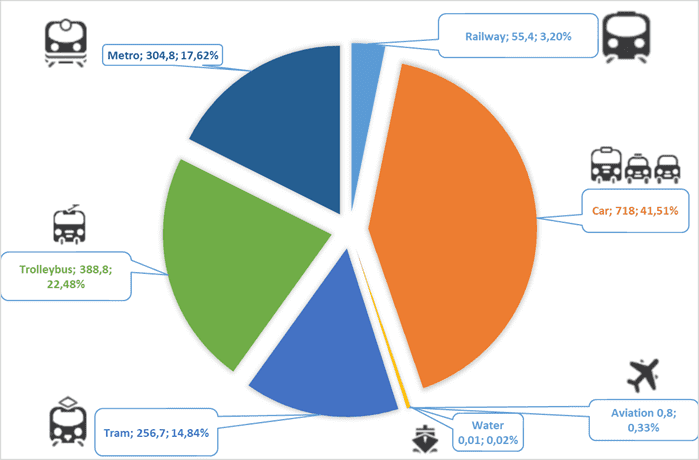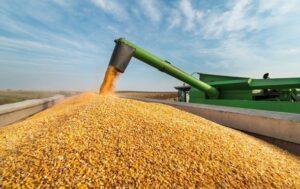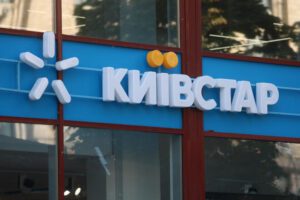
The statistics on COVID-19 incidence gives no reason to hope that Ukraine will remain in the green zone for the European Union, Head of the Parliament Committee on Public Health, Medical Assistance and Medical Insurance Mykhailo Radutsky says.
“Ukraine is already in the red zone for the United States and Switzerland. The EU has given a delay of one week, most likely the EU will place us in the red zone. Unfortunately, statistics does not give us hope that we will remain in the green zone,” he said on the sidelines of Savik Shuster’s Freedom of Speech (Svoboda Slova) talk show on Friday night.
“We will wait for the next meeting of the European Commission,” Radutsky said.

Introduced from November 1, the lockdown in Kyiv will be valid for the unvaccinated, mayor of the city Vitali Klitschko has said.
“From November 1, the Ukrainian capital is included in the ‘red zone’ […] We are counting on clear interaction with the police. To monitor compliance with the key rules: both for travel in transport and for visiting various establishments. I want to emphasize once again that today the lockdown in Kyiv will be valid for those people who are not vaccinated,” the press service of Klitschko quotes his words, said on the air of the Freedom of Speech program with Savik Shuster on the Ukraine TV channel on Friday.
According to him, there is very disappointing statistics in Kyiv – 40-50 people died every day over the past week. Statistics will be released on Saturday that 54 people have died over the past day. “The situation is very difficult. And we are doing everything possible to help doctors from the capital’s budget, motivating them. We buy oxygen. As of today, we have no problems with provision to hospitals,” Klitschko said.
At the same time, he noted that the Ukrainian capital today is the leader in vaccination among other Ukrainian cities and regions. In total, since the beginning of the vaccination campaign in the Ukrainian capital, about 2.200 million vaccinations have been carried out.

Poland has become the main destination country for labour migrants from Ukraine, according to the publication “Migration in Ukraine: Figures and Facts” prepared by the International Organization for Migration, the United Nations Agency for Migration in Ukraine (IOM).
“Emigration to the Czech Republic, Slovakia, and Hungary has increased in a certain way. As before, Poland is the main destination for Ukrainians,” Doctor of Public Administration, expert on migration issues Olena Malynovska said at the presentation of the publication in Kyiv on Friday.
In particular, in 2020, some 1.329 million applications of Polish employers about their intention to employ a citizen of Ukraine were registered. It is estimated that the labor participation of Ukrainians in the Polish economy has provided 13% of its growth in recent years.
“There has been a noticeable increase in the number of applications by Ukrainians to acquire a long-term or permanent permit to stay abroad, in particular in Poland. The pandemic, which limited the possibility for circular migration, that is, periodic trips abroad, has led to an intensification of the tendency for a part of temporary labor migration to become permanent or for a long migration,” Malynovska said.
According to the publication, in 2020, private remittances to Ukraine amounted to $11.888 billion, while foreign direct investment amounted to $868 billion less.
In addition, in 2020, Ukraine issued 12,000 immigration permits and 293,600 permanent residence permits.
“The number of foreign students has been growing, and this is a positive phenomenon, but I want to draw your attention to the fact that last year there was a third less invitations for applicants, that is, the replenishment of the contingent of foreign students last year took place at a lower level. In the coming years, we will have a reduction in the number of foreign students,” Malynovska said.
According to the data indicated in the publication, the number of immigrants on the territory of Ukraine is decreasing, while the number of emigrants is growing. In particular, 4.997 million people of immigrants lived in Ukraine in 2020 (some 6.893 million people in 1990), while 6.139 million people of emigrants from Ukraine lived abroad (some 5.546 million people in 1990).
According to the Ministry of Social Policy of Ukraine, as of July 2021, the total number of internally displaced persons (IDPs) in Ukraine reached 1.474 million people.
The publication informs that in 2020 the population of Ukraine was 41.6 million, while in 2018 the population was 42.4 million. It is noted that in 2020, some 616,800 people died in Ukraine, and 293,400 people were born.
It is indicated that Ukraine’s GDP is still below the 2013 level. In particular, in 2020, Ukraine’s GDP was $142.3 billion, while in 2013 it was $183.3 billion. At the end of 2020, the unemployment rate in Ukraine was 10.1%, which was the highest since 2014. It is noted that the poverty level in Ukraine is 23.3%, below the poverty line are 8.8 million citizens. Previously the Experts Club made an analytical program dedicated to the Ukrainian demography in 1990-2021 period. For more details on the analysis of the demographic situation in Ukraine, see the video posted on the Experts Club channel: https://www.youtube.com/watch?v=Gc04wUpexnE
You can subscribe to the Experts Club channel here.
PASSENGERS CARRIED IN JAN-AUGUST OF 2021, IN MLN


Ukraine since the beginning of this season and as of October 28 threshed 60.75 million tonnes of main grain and leguminous crops from a total area of 12.86 million hectares (a rise of 4.37 million tonnes in a week from October 21 to October 28), the Ministry of Agrarian Policy and Food reported on its website f on Friday.
According to the report, Kharkiv region with 4.61 million tonnes, as well as Odesa (4.58 million tonnes), Dnipropetrovsk (4.53 million tonnes), Mykolaiv (3.78 million tonnes), Vinnytsia (3.77 million tonnes) and Kherson (3.44 million) regions are leaders in threshing.
In total, 80.19 million tonnes of major grains, legumes, oilseeds (and sugar beets were dug out) from a total area of 20.89 million hectares have been harvested this season (a rise of 5.7 million tonnes in a week).
As the Ministry of Agrarian Policy said, as of the indicated date, 15.62 million tonnes of corn (a rise of 4.47 million tonnes) were harvested from 2.43 million hectares (44% of the forecast) and 13.56 million tonnes of sunflower (a rise of 0.88 million tonnes) from 5.87 million hectares (90% of the forecast).
In addition, farmers harvested 7.76 million tonnes (a rise of 1.53 million tonnes) of sugar beet from 164,630 hectares (73% of the forecast).
The ministry said that a total of 107,500 tonnes (a rise of 1,000 tonnes) of buckwheat was harvested from 81,600 hectares (98% of the forecast), and 178,800 tonnes of millet from 76,300 hectares (98%).
In addition, 3.05 million tonnes of soybeans (a rise of 450,000 tonnes) were harvested from 1.15 million hectares (90% of the forecast).
The Ministry of Agrarian Policy also recalled the completion of work on harvesting rapeseed, which harvested 2.91 million tonnes from an area of 1.01 million hectares.
The average yield of corn as of October 28 was 6.436 tonnes per ha, sunflower – 2.312 tonnes per ha, soybeans – 2.647 tonnes per ha, rapeseed – 2.86 tonnes per ha, sugar beet – 47.113 tonnes per ha, buckwheat – 1.38 tonnes per ha, millet – 2.344 tonnes per ha.

The mobile operator Kyivstar has received a partnership format extended to the level of Licensing Solution Provider (LSP), which gives the right to work with cloud solutions from Microsoft in the market of large enterprises and the public sector – to supply licensed products under corporate agreements and provide them with appropriate technical support.
As noted in a statement of the operator on Friday, earlier Kyivstar had a Cloud Services Provider (CSP) authorization, with which the company could sell online services and software licenses on a subscription basis, as well as perpetual licenses for local software.
The LSP status substantially complements these capabilities and allows Kyivstar to supply Microsoft products to the Ukrainian market under the Enterprise Agreement (EA) and Enterprise Agreement Subscription (EAS) corporate licensing programs.
“For more than five years, Kyivstar has been developing the direction of selling cloud products for the company’s business clients […] The LSP status that we have received is granted to the largest and most reliable Microsoft partners who have confirmed their professionalism in working with cloud products of the world-famous corporation. It enables Kyivstar to create unique offers for business based on the needs of specific clients,” Ilya Polshakov, Director of New Business Development at Kyivstar, is quoted in the message.
The company notes that the combination of Kyivstar’s CSP and LSP capabilities enables the operator to provide business customers with: an expanded set of Microsoft licensed solutions; new opportunities for the development of hybrid solutions; access to licensing agreements that take into account the needs of companies of different tiers; the ability to negotiate non-standard conditions with Microsoft, as well as the expertise and assistance of qualified specialists in selecting the optimal licensing strategy for the needs of a particular business.
Kyivstar is the largest Ukrainian telecommunications operator. It provides communication and data transmission services based on a wide range of mobile and fixed technologies, including 3G. By the end of 2018, its services were used by about 26.4 million mobile subscribers and about 900,000 fixed Internet customers.
The shareholder of Kyivstar is the international group VEON (formerly VimpelCom Ltd.). The group’s shares are listed on the NASDAQ (New York) stock exchange.